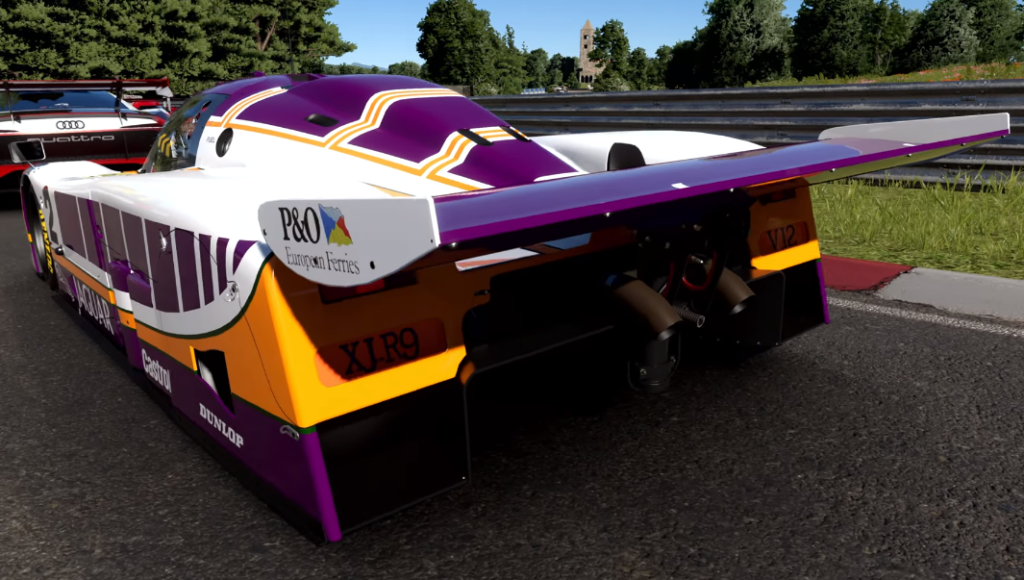The Jaguar XJR-9 holds a special place in the annals of motorsport history. This sports-prototype race car, designed and built by Jaguar in collaboration with Tom Walkinshaw Racing (TWR), made its debut at the prestigious 24 Hours of Daytona in 1988, leaving an indelible mark on the racing world.
The XJR-9 was an evolution of its predecessor, the XJR-8, and featured a sleek and aerodynamic design crafted by the renowned Tony Southgate. Under the hood, it boasted a formidable Jaguar 7.0-litre V12 engine, derived from the production 5.3-litre engine used in the Jaguar XJS road car. This powerful engine propelled the XJR-9 to incredible speeds and ensured its competitiveness on the race track.

In the United States, the Castrol-sponsored XJR-9 made an impressive debut at the 24 Hours of Daytona, securing an overall victory. However, throughout the rest of the IMSA Camel GTP season, the XJR-9 struggled to replicate its initial success, with only one more win to its name. Nevertheless, the team’s triumph at Daytona earned them a third-place finish in the constructor’s championship. In contrast, the XJR-9 found more success in the 1988 World Sports Prototype Championship, clinching six victories, including a remarkable win at the 24 Hours of Le Mans. The triumph at Le Mans was particularly noteworthy as it marked the first time since 1980 that Porsche had not claimed victory at the prestigious endurance race, and it signified Jaguar’s return to glory at Le Mans since their last victory in 1957.
The following year, the XJR-9 faced stiffer competition in both the IMSA Camel GTP and the World Sports Prototype Championship. While it achieved only a single win in the IMSA series, the XJR-9 was gradually overshadowed by newer and more advanced rivals from Nissan. Jaguar responded by introducing the XJR-10 midway through the season, which demonstrated slightly better performance and secured two victories. In the 1989 World Sports Prototype Championship, Jaguar failed to secure a single race win, leading to the development of the XJR-11 as a replacement for the aging XJR-9. Although the XJR-9 soldiered on until the end of the season, Jaguar’s lackluster performance resulted in a fourth-place finish in the Teams Championship.

Despite its racing disappointments, the legacy of the XJR-9 extended beyond the track. TWR repurposed the XJR-9 chassis to develop the R9R prototype, which ultimately evolved into the iconic XJR-15 sports car and spec-racer by 1990.
Fast forward to the present day, and the Jaguar XJR-9 continues to captivate the imaginations of racing enthusiasts. Its illustrious history and striking design have earned it a coveted spot in the upcoming Gran Turismo 7 game for the PlayStation 5. Players will have the opportunity to experience the power and grace of the XJR-9, reliving its racing triumphs and pushing its performance to the limit in the virtual world.

Under the hood, the XJR-9 boasts a formidable 7.0-litre V12 engine, generating an impressive 750 horsepower and 828 Nm of torque. Its carbon composite body and carbon fibre/Kevlar monocoque chassis contribute to its lightweight yet robust construction. With a power-to-weight ratio of 0.85 bhp/kg and a top speed of 245 mph (394 km/h), the XJR-9 delivers exhilarating performance on the virtual race track.
As the release of Gran Turismo 7 draws nearer, anticipation builds for the opportunity to experience the iconic Jaguar XJR-9 firsthand. From its triumphant victories at Le Mans to its enduring legacy in the world of motorsport, the XJR-9 remains a symbol of Jaguar’s racing prowess and a testament to the pursuit of excellence on the race track. Get ready to strap in, rev the engine, and take on the world in the legendary Jaguar XJR-9 in Gran Turismo 7.
